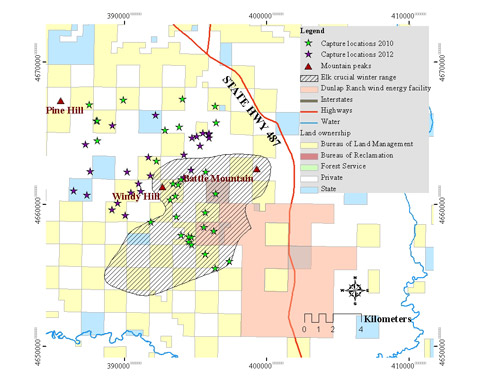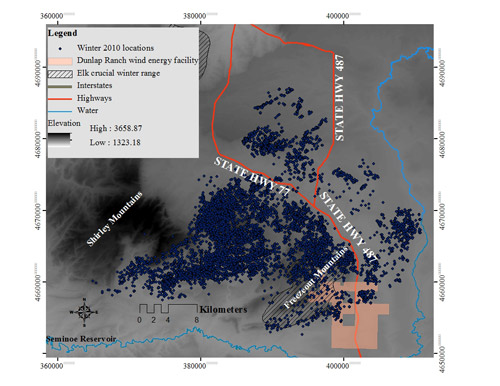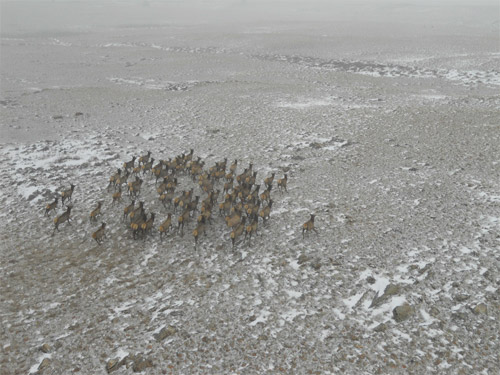

Dr. Jeffrey L Beck
Dept of Ecosystem Science and Management
Agriculture Building 2004
Department #3354
1000 E. University Ave
Laramie, WY 82071
Phone: (307) 766-6683
Fax: (307) 766-6403
Email: jlbeck@uwyo.edu
Dr. Jeff Beck
Postdoctoral Research Associate: Kurt Smith
Understanding wildlife response to energy development is important on landscapes with high potential for resource production. Elk (Cervus elaphus) occur in many areas with potential for energy development and are a popular game species throughout Wyoming. Evaluating the influences of energy development for elk on winter ranges is particularly critical given that severe climate conditions generally lead to nutritional deprivation and decreased performance of ungulate populations during winter. Behavioral responses to predation risk such as avoidance, fleeing, increased vigilance, and reduced feeding time, have also been documented in response to disturbance in several species. Avoidance of resource rich habitats where danger is perceived as high can lead to depreciating effects on reproduction and fitness of individuals. Recent research from northeastern Wyoming reported distributional shifts in elk in response to oil and gas development, whereby areas of highest use by elk before development declined during development (Buchanan et al. 2014). In addition, a study from southern Colorado demonstrated decreasing elk survival in an area supporting oil and gas production (Webb et al. 2011). Walter et al. (2006) evaluated home range size and dietary quality for elk that were influenced by wind energy development in southwestern Oklahoma; however, no studies have evaluated the influence of wind energy development on elk habitat selection and migration patterns. A better understanding of potential impacts to elk occupying areas developed for wind energy can lead to improved mitigation measures to lessen impacts to wintering elk populations.
We began investigating elk response to wind energy development in January 2010 on the Dunlap Ranch, a 62.2 km2 (24 mi2) wind energy resource area north of Medicine Bow, Wyoming. The Dunlap Ranch facility is proposed to eventually consist of a two phase construction process, where 74 wind turbine generators were constructed in Phase I adjacent to elk crucial winter range during spring 2010. If constructed, Phase II will include the construction of additional turbines on elk crucial winter range, with the construction to begin at a later time. Our study encompasses two samples of elk captured on or near the Dunlap Ranch: 1) Sample 1 (n = 30 elk), representing the first 3 winters of pre-construction data (Winter 2010, winter 2010–2011, and winter 2011–2012) for a potential Phase II wind energy facility, and 2) Sample 2 (n = 31 elk), representing winters 2012–2013, 2013–2014, and 2014–2015 of pre-construction data for a potential Phase II wind energy facility.
The primary objective of our research is to evaluate winter resource selection by elk on crucial winter range prior to wind energy development. We acknowledge Kaitlyn Taylor for maps and a photo of elk being pursued for helicopter netgun capture in December 2012. Funding was provided by PacifiCorp.
Literature Cited
Buchanan, C. B., J. L. Beck, T. E. Bills, and S. N. Miller. 2014. Seasonal resource selection and distributional response by elk to development of a natural gas field. Rangeland Ecology and Management 67:369–379.
Walter, W. D., D. M. Leslie Jr., and J. A. Jenks. 2006. Response of Rocky Mountain elk (Cervuselaphus) to wind-power development. American Midland Naturalist 156:363–375.
Webb, S. L., M. R. Dzialak, J. J. Wondzell, S. M. Harju, L. D. Hayden-Wing, and J. B. Winstead. 2011. Survival and cause-specific mortality of female Rocky Mountain elk exposed to human activity. Population Ecology 53:483–493.



Dr. Jeffrey L Beck
Dept of Ecosystem Science and Management
Agriculture Building 2004
Department #3354
1000 E. University Ave
Laramie, WY 82071
Phone: (307) 766-6683
Fax: (307) 766-6403
Email: jlbeck@uwyo.edu